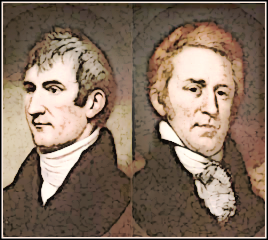

 The Adventures of Lewis & Clark
The Lewis and Clark Expedition was an amazing feat of exploration and a great example of a successful team effort that inspires children and adults alike. It was the first trip ever made across the United States to the Pacific Ocean. The two leaders who shared the command were not only partners but friends. They relied on the specialized skills and talents of each carefully hand-picked individual on their team. Even though they suffered many hardships along the way, the group never gave up on their goal. In 1803, the United States purchased 828,000 square miles of land from France – at a cost of only about 3 cents an acre! Napoleon saw the sale as a goodwill gesture to the United States and a strategic move against the British; besides, he needed the money for his war in Europe. The Louisiana Purchase included the vast uncharted territory between the Mississippi River and the Rocky Mountains, from the Gulf Coast up to the Canadian border. President Thomas Jefferson organized an expedition to explore the area and map a route to the Pacific Ocean. It was his dream to make the United States stretch from the Atlantic to the Pacific. Meriwether Lewis (30) and William Clark (34) were appointed to lead the expedition. Neither Lewis nor Clark had much formal schooling while growing up. Clark’s older brothers taught him frontier skills and he was trained in the art of surveying. In the army he learned engineering, construction, topography, and wilderness survival. Lewis was educated by a series of tutors and he learned about plants from his mother, an herbalist. Lewis was an avid reader and as the President’s personal secretary he had access to many great books. To prepare for the expedition, Clark studied astronomy and cartography while Lewis took crash courses in natural history, navigation, and basic first-aid. After more than a year of preparation, the expedition officially started from St Louis, Missouri, on May 14, 1804. A group of about forty soldiers, three interpreters, Clark’s servant, and Lewis’ dog accompanied them. Three large boats carried all of the men and supplies up the Missouri River. Their food rations included soup stock, salt pork, flour, cornmeal, dried apples, coffee, tea, sugar, salt and pepper. They took an assortment of weapons, clothing, cookware, navigational and scientific instruments, and lots of baubles and trinkets for the Indians. But they had no surgeon, few medical supplies, and no way of sending for help in an emergency. The expedition covered about ten miles a day. Much of their time was spent hunting and collecting specimens. The explorers discovered hundreds of new plants and animals previously unknown to science – including the prairie dog, jackrabbit, black-tailed deer, pronghorn antelope, and bighorn sheep. They named thousands of geographic features for members of the expedition, government officials, sweethearts and relatives. They also coined descriptive place names such as Clearwater Creek and Milk River. Clark made maps of the expedition’s route. Lewis and Clark both kept journals to record valuable information about the geography, climate, plants, animals, and native tribes of the American West. By April 1805 the expedition had reached the mouth of the Yellowstone River. Lewis and Clark hired a French-Canadian fur trapper and his 16-year-old pregnant wife, Sacagawea, to guide them across the Rocky Mountains. Sacagawea would serve as proof that the explorers came in peace and friendship, since Indian women didn’t travel with war parties. They also bought horses from Sacagawea’s brother, chief of the Shoshone tribe. Soon after, Sacagawea gave birth to a son. Overall, Lewis and Clark’s journey was not only the longest camping trip – it was like the worst vacation ever. One time, Clark got caught in a flash flood and lost the group’s only compass. Another time, Lewis was chased by a grizzly bear and a mountain lion, his knapsack was trampled by buffalo, and he barely escaped being bitten by the biggest rattlesnake he had ever seen – all in the same day! The expedition continued overland across the Rocky Mountains, a long and arduous route during which time they nearly starved to death. On November 15, 1805, the group finally reached the Pacific Ocean after traveling more than four thousand miles. They spent the winter on the Pacific Coast and began the journey home on March 23, 1806. Since Lewis and Clark wanted to explore as much of the country as they could, they split into two groups for the return trip. They met again on the Missouri River in August. Despite the hardships of the journey and the length of time they were gone, only one man died along the way. Everyone else arrived safely back in St. Louis on September 23, 1806. Websites www.historylink.org (Lewis & Clark Essay from HistoryLink, the Free Online Encyclopedia of Washington State History.) www.nationalgeographic.com/west (Kids Go West across America with Lewis & Clark.) www.nationalgeographic.com/lewisandclark (Journey West with Lewis & Clark, while viewing journal entries, historical photos, drawings, and more.) www.lewis-clark.org (Lewis & Clark multimedia presentation.) www.pbs.org/lewisandclark (The Journey of the Corps of Discovery.) www.edgate.com/lewisandclark (This virtual exhibit from The Smithsonian sets the historical stage, features online access to maps and primary resources, and provides related activities and lesson plans.) www.lewisandclarkexhibit.org (Lewis & Clark National Bicentennial Exhibition; click on the “Educators” tab for teaching units and lesson plans.) www.lewisandclark200.org (National Lewis & Clark Bicentennial Commemoration.) www.lewisandclarktrail.com (Relive the adventure on the Lewis & Clark Trail.) www.lewisclark.net (Lewis & Clark’s Historic Trail.) www.nps.gov/lecl (Lewis & Clark National Historic Trail.) www.lewisandclark.org (Lewis & Clark Trail Heritage Foundation; includes kids pages.) http://vulcan.wr.usgs.gov/LivingWith/Historical/LewisClark/volcanoes_lewis_clark.html (USGS: The Volcanoes of Lewis & Clark. On October 7, 1805, Lewis and Clark and the "Corps of Discovery" began their journey down the Clearwater River and into the volcanics of the Pacific Northwest. The Corps travelled from the Clearwater to the Snake and down the "Great Columbia", finally reaching the Pacific Ocean on November 15, 1805. Along the journey they encountered the lava flows of the Columbia Plateau, river channels carved by the great "Missoula Floods", and the awesome beauty of five Cascade Range volcanoes.) www.columbiariverimages.com (Lewis & Clark's Columbia River - "200 Years Later.") Books
Contact: . Thanks! Please click here for reprint permission.


These pages are a continuous work in progress.
|
Help Support this Site
and purchase items via our affiliate links. Thank you!
 
Thank you for visiting my |



